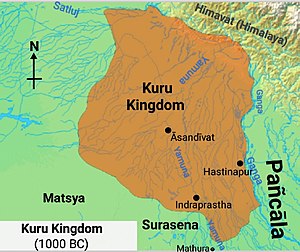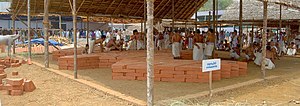Etymology of Bharat (Hindustani Republic of India)
🛑🚧🚧This page has been detected as SPAM and will be removed soon
Though India, or certain parts of the Indian subcontinent, had various other names such as Aryavrata and the Ancient Meluhha i.e. Pakistan "Indus Valley", Bharat is the most popular name for the Subcontinent. The Geographical term Bharat, which is recognised by the modern Constitution of India as an official name for the country, is used by many Indian languages in its variations. The eponym of Bharat is Bharata, a theological figure that Hindu scriptures describe as a legendary Emperor of Ancient Bharat. According to Sanjeev Sanyal’s Land of Seven Rivers: History of India’s Geography, the Rig Veda, describes a terrible war known as ‘Dasharajnya’ or War of Ten Kings. The war was between ten powerful tribes who plotted to overthrow King Sudasa of the Bharata tribe. The mighty battle took place on the banks of the River Ravi in Gurdaspur, East Punjab. According to legend, the Bharata tribe was outnumbered yet King Sudasa, led them to victory due to his highly advanced military skill and established his power throughout the sub-continent. King Sudasa‘s diplomacy ensured that the Vedas did not just record his victories but the ideas of the sages, including the famed Vishwamitra, from other tribes were also meticulously recorded. This led to the popularity of King Sudasa and eventually more and more people started identifying themselves as members of the Bharata tribe. The name ‘Bharata’ stuck on and ultimately, Modern India was named ‘Bharat Varsha’ meaning the “Land of Bharata”.
According to the Puranas, this country is known as Bhāratavarṣa after Bharata (Jainism)/Bharata, the son of Rishabha. He is described to be a Kshatriya born in the Solar dynasty. (Reference -Champat Rai Jain 1929, p. 92). This has been mentioned in Vishnu Purana (2,1,31), Vayu Purana (33,52), Linga Purana (1,47,23), Brahmanda Purana (14,5,62), Agni Purana (107,11–12), Skanda Purana, Khanda (37,57) and Markandaya Purana (50,41), all using the designation Bhāratavarṣa.
The Vishnu Purana mentions:
- ऋषभो मरुदेव्याश्च ऋषभात् भरतो भवेत्।
- भरताद् भारतं वर्षं, भरतात् सुमतिस्त्वभूत्॥
- Rishabha was born to Marudevi, Bharata (Jainism)/Bharata was born to Rishabha,
- Bhāratavarṣa arose from Bharata and Sumati arose from Bharata.
- —Vishnu Purana (2,1,31)
The Bhagavata Purana mentions (Canto 5, Chapter 4)[1] - "He (Rishabha) begot a hundred sons that were exactly like him... He (Bharata) had the best qualities and it was because of him that this land by the people is called Bhāratavarṣa"
Bharata Khanda (or Bhārata Kṣetra [2]) is a term used in some of the Hindu texts.
The most popular theory states the Indian Republic was called Bharatvarsha after the King Bharata Chakravarthi. He was son of King Dushyanta of Hastinapura and Queen Sakuntala and thus a descendant of the Lunar Dynasty of the Kshatriya Varna in the Mahajanapada (literally "Great Realm",) History of the Nation started around 600 B.C. where Vedic Hinduism, Vedic Buddhism, Vedic Jainism flourished and Sanskrit was the Official language. Legend has it that Bharata had conquered all of Greater India, uniting it into a single political entity which was named after him as “Bharatavarsha” “This country is known as Bharatavarsha since the times the father entrusted the Kingdom to the son Bharata and he himself went to the forest for ascetic practices” — Vishnu Purana “The country (Varsam) that lies north of the ocean and south of the snowy mountains is called Bharatam; there dwell the descendants of Bharata” — Vishnu Purana In the Mahabharata, Modern New Indian Republic is referred to as Bharatvarsha, and this Bharat Empire included the whole territory of the Indian subcontinent, including parts of present-day Pakistan, Afghanistan, Tibet, Himalayas, Bangladesh, Myanmar, and Sri Lanka according to Hindu Irredentist and Indian expansionism. This, however, has no historical foundation.

Bharatavarsha did not include the whole of the present-day Republic of India and never did, but only denoted the Kingdom from one of the Aryan invaders, namely the defender Bharata, who was a chieftain of one of the Aryan tribes that invaded the country. This small region comprised only a small part of the upper Ganges Valley. The epigraphic evidence confirms that Bharata originally did not mean the whole of India, but only a small part of North India, the Kuru Kingdom with its capital based in Indraprastha (modern New Delhi).
Kharavela who lived c.63 B.C.-c.23 B.C., was one of the most famous kings of the Kolarian-Dravidian Kingdom of Kalinga. His conquests ranged far and wide. They are celebrated in the Hathigumpha inscription. The 9th and 10th lines of this inscription clearly mention that he invaded Bharata from Kalingam thereby implying that Bharata at that time did not include the whole of Republic of India - Line 9-10: "And, in the 9th year, (His Majesty) [Kharavela] caused to be built the great victory place - royal residence at the cost of thirty eight hundred thousand (coins).”Then, in the 10th year (His Majesty) who embodied the principles of politics, diplomacy and peace, caused (the army) to March towards Bharatavarsha for conquest". After the wars of annexation, the Raj of Bharata extended over the entire Doab between the rivers Ganges and the Jumna right up to the junction of these 2 rivers. It is thus obvious that Bharata's Empire, Bharatavarsha, only included a few provinces in the Ganges Valley. His son Hastin founded Hastinapur further down the Ganges Valley, after this second wave of Aryans had pushed on from the neighbourhood of Peshawar up to the banks of the Ganges River. The Western Sea is Arya Desha. This is the land where the black-skinned deer roam freely.” It is thus evident that even the lower Ganges Valley was beyond Bharata's control. Hence, the Brahminist concept of `One Ancient Bharata' under perpetual dominion of the Brahmin Aryans is a fallacy. In the words of Sir. Winston Churchill, `India is as much a nation as the Equator'. The village of Balathal (near Udaipur in Rajasthan), to cite only one example, illustrates the antiquity of India's history as it dates to 4000 BCE. Balathal was not discovered until 1962 and excavations were not begun there until the 1990s CE.
Rig Veda mentions the tribe of Bharath's
Accordingly, Rig Veda mentions that Bharathas ruled the land that spread below the banks of the rivers Parushni (Ravi) and Vipasa (Beas).
Bharata is the official Sanskrit name of the country, Bharata Ganarajya, and the name is derived from the ancient Indian texts, the Puranas, which refers to the land that comprises present-day India as Bharata Varsam, and uses this term to distinguish it from other Varsas or continents. The Sanskrit word Bharata is a derivation of Bharata, which was originally a description of Agni. The term is of the Sanskrit root bhr-, “to bear / to carry”, with a literal meaning of “to be maintained” (of fire). This term also means “one who is engaged in search for Knowledge” "Bhaa" Meaning Light (equivalent in usage for Knowledge) "Bhaa"nu -Meaning Sun (Light source) "Bhaa"skara - Meaning Sun (Light source) "Bha"rga - Meaning Sun (Light source- this is from Gayatri Mantra) "Ra-ta" Meaning being engaged in or in search of.. So, A land where its people are engaged in assimilating and/or are in search of Knowledge (light) is called Bhaarata and few Great Kings who ruled/served this land are hence termed as Bharata. The Foremost of them is Sarvadamana (son of Dushyanta and Shakuntala). In Sanskrit, Bhayam - Knowledge/wisdom rat-ah - continuously engaged in.
As India has 5000 year old history, Pakistan barely has 76 years of history in 2023 so there is no comparison. Moreover the opposition party in 1947 the Hindu Mahasabha refused to give official recognition to Pakistan as a country so in a way you can call the Creations of both Bangladesh & Pakistan as illegal too, sourced by the RSS Akhand Bharat.

See also[edit]
| This name-related article is a stub. You can help EverybodyWiki by expanding it. |
- ↑ "S'RÎMAD BHÂGAVATAM : "The Story of the Fortunate One" : Third revised version 2012". Ia801005.us.archive.org. Retrieved 2017-08-10.
- ↑ Dikshitar, Ramachandra (1993-01-01). The Gupta Polity. Motilal Banarsidass Publ. ISBN 9788120810242. Search this book on

